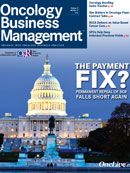Publication
Article
Oncology Business News®
Enabling At-Risk Bundled Oncology Reimbursement: Why, When, and How
Author(s):
The current state of affairs in oncology care reimbursement is in flux, with the promise for dramatic change. It is hoped that change will foster value-based oncology care delivery, avoid the need to ration care indiscriminately, and allow for continued discovery and advancement. Good luck!
Andrew L. Pecora, MD
Editor-in-Chief of Oncology Business Management
Chief Innovations Officer, Professor, and Vice President of Cancer Services John Theurer Cancer Center at Hackensack University Medical Center
President, Regional Cancer Care Associates, LLC
The current state of affairs in oncology care reimbursement is in flux, with the promise for dramatic change. It is hoped that change will foster value-based oncology care delivery, avoid the need to ration care indiscriminately, and allow for continued discovery and advancement. Good luck!
Why would we take something as complex as oncology care and tackle cost control through a new reimbursement strategy? The need to control the growth rate of cost in oncology is undeniable. The cost “problem” has been created, in part, by our cardiology colleagues, who by their collective success have done a good job of preventing premature death from cardiovascular disease, and by our own efforts in extending progression-free survival and overall survival. As more patients with cancer receive therapy that is increasingly expensive, with new drugs and technology that improve outcomes but compound costs, the need to impose controls increases.
The second issue—moving reimbursement toward at-risk bundling—may not be as clear. In short, if providers risk financial loss for overutilization and are rewarded for proper utilization (not underutilization), this approach may help to control costs and preserve quality.
Implementing change of this type at scale, however, is fraught with major practical challenges, including but not limited to different electronic health record (EHR) systems, lack of standardization of diagnostic/prognostic up-front patient characterization, and lack of standardization of outcome reporting, including incidence and severity toxicities, delivered dose intensity, and clinical efficacy outcomes. Simply stated, the goal is to avoid the need to indiscriminately ration care and instead follow the Goldilocks formula— not too much care, not too little care, but just the right amount of care at scale.
Why would providers of cancer care want to do this? Well, moving from claims-based to claimless reimbursement and eliminating precertification authorizations are 2 good reasons to start. If only it were this simple. Again, good luck! With the rapid move to more personalized medicine driven by genomics and the more frequent approval of new and expensive agents and technologies, it becomes imperative to slow down rising healthcare costs.
To solve complex problems, one must look for least common denominators. To that end, oncologists need to use the language of oncology and genomics (ie, not ICD-10), so results of the comparison of clinical and cost outcomes between patients and between providers is the result of clinical intervention, and not reflective of the starting population.
Next, outcomes assessment must be defined and standardized nationally. The good news here is that the FDA drug approval process provides standard definitions. Doctors and nurses are spending the majority of their time on data entry as the use of EHRs grows, so the solution must avoid double data entry requirements. Software is now available that can facilitate patient sorting and outcomes tracking. Evidence-based standards for treatments are readily available to oncologists, so packaging care into “bundles” is doable, albeit tedious. Underutilization needs to be tracked and guarded against.
In sum, payers and providers appear able and ready to move forward and test at-risk bundles where the total cost and service provided is fixed up front, transparent, and tied to achievable outcomes. At-risk bundles hold promise because rationing is avoided. This payment model will drive savings through repeated outcomes tracking and reporting. Now all we need to do is to get started. Good luck!









